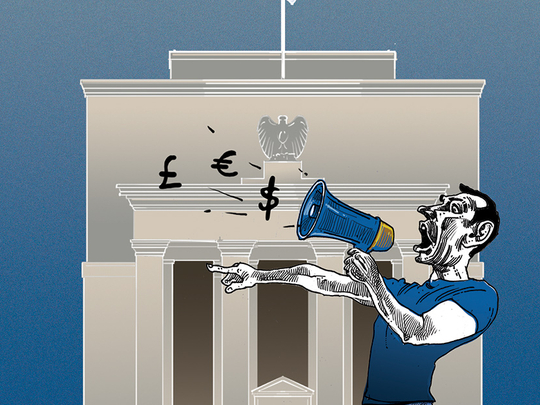
Throughout 2016, populist movements in developed countries have set their sights on central-bank independence. To the populist bull, unelected technocrats wielding policies that have political and distributional consequences may as well be waving a red cape.
In the US, a bill seeking to audit the Federal Reserve — and thus to subject quotidian monetary-policy decisions to congressional review — was narrowly defeated in early 2016. And, during his campaign, President-elect Donald Trump accused Fed Chair Janet Yellen of politicising Fed decision-making.
In Europe, the populist clamour against unelected European Union bureaucrats and the independent European Central Bank has grown louder; and in the UK, Labour Shadow Chancellor of the Exchequer John McDonnell has called for “democratic control” over interest rates, implying that the Bank of England’s monetary policy has been geared toward helping financial institutions.
With populist movements gaining ground, and even joining some governments, their complaints will, sooner or later, translate into policy proposals that could change the relationship between central banks, treasuries, and legislatures. A large question for 2017 is whether that would be a good thing, or whether central-bank independence should be defended against the coming populist attack.
The diverse range of critiques against central banks have included claims that quantitative easing (QE) and low interest rates favour the rich; special credit policies favour the banks, without really helping the economy; and the keen focus on inflation comes at the expense of other objectives, such as maintaining full employment and combating inequality.
These arguments come from both the left and the right, and some overlap with concerns voiced by conservative economists, that central banks have assumed an excessive role in managing the economy since the 2008 financial crisis.
Extraordinary policies such as QE and long-term lending facilities, and some central banks’ increased involvement in the financial sector, have pushed the boundaries of monetary policymakers’ legitimate remit.
But, whereas populists tend to favour limiting central banks’ political and operational independence, and broadening their mandate, conservative economists want the opposite: to maintain central banks’ independence while limiting their mandate and policymaking scope.
The concept of central-bank independence originated in the 19th century, and has evolved differently in various currency areas. But it was only more recently, that central-bank independence became linked to inflation targets.
While some central banks have more flexibility than others in managing price stability, they have all publicly committed to numerical targets. Without such accountability (and transparent communication), their independence would be hard to justify.
Numerical targeting of price stability was born of the inflationary 1970s; but central banks have struggled with the opposite problem since 2008: low inflation, or even deflation, when short-term interest rates have reached the zero lower bound. More broadly, the financial meltdown has challenged the intellectual framework and some of the key principles that previously guided virtuous central banking.
For example, we can no longer treat capital-market friction as merely a second-order indicator; nor can we assume that the efficient market hypothesis will always provide a workable approximation of market activities, or that financial quantities — particularly the size and structure of central-bank balance-sheets — are irrelevant.
Owing to pervasive market failures, central banks have been able to step in as market makers and influence risk premia through active balance sheet policies.
As a consequence, central banks’ operational framework has changed. With more instruments such as QE at their disposal, central banks have moved from a one-instrument, one-target model, to one with multiple instruments and multiple targets.
This change was precipitated by the financial crisis, but we can expect that central banks will continue to use their balance-sheets proactively even in “normal times,” to counter financial friction or address liquidity squeezes.
This new operational model could be justified as a means to ensure price stability, but when central banks are mandated to maintain financial stability as well, central-bank accountability, and thus central-bank independence, is threatened.
Moreover, in a debt-ridden, low-inflation environment, central banks may not even be able to achieve price stability unless they coordinate with fiscal authorities.
As we have learnt in recent years, maintaining a “Chinese wall” between fiscal and monetary policymakers can result in excessive delegation of responsibilities to central bankers.
As we head into 2017, these are the two problems that stand out — the weakening of accountability when central banks are given multiple objectives, and the incentive — particularly visible in the Eurozone — for fiscal authorities, which must answer to voters, to push all responsibility onto independent central banks.
If we believe that central banks should be protected from short-term political interference as they pursue monetary-policy objectives, it behoves us to implement reforms that will allow for democratically accountable coordination among monetary, fiscal, and financial authorities. This will probably require that other parts of the government be granted a degree of independence to pursue clear, quantifiable objectives under public scrutiny.
Central banks have come to play a major role in economic policymaking, but fiscal policy is now back, partly owing to populist pressure. The challenge ahead — which will be particularly difficult to meet in the Eurozone — is to ensure that monetary and fiscal policies alike are effective and legitimate.
Populist solutions may be ill-advised, but the problems populists have identified with respect to central banks are real.
— Project Syndicate, 2016
The writer is a Professor of Economics at the London Business School.












